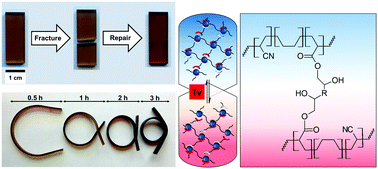Stress relaxation and thermally adaptable properties in vitrimer-like elastomers from HXNBR rubber with covalent bonds†
Abstract
Widening the scope of skeletons in the chemistry of vitrimer(-like) high molecular weight rubbers, the present study highlights the preparation of vitrimer-like elastomers based on a technically relevant rubber that is characterised by high thermal and oxidation stability. In particular, we prepared covalently crosslinked hydrogenated carboxylated nitrile butadiene rubber (HXNBR) networks that can rearrange their topology due to the exchangeable nature of the crosslinks. By crosslinking with a di-functional epoxide, β-hydroxyl ester linkages are incorporated into the rubber, enabling thermo-activated transesterifications in the presence of the catalyst triazabicyclodecene. At moderate temperatures, the covalent linkages ensure good mechanical properties as well as chemical and thermal stability of the rubber, which is essential for most applications. In addition, bond exchange reactions allow for fast and distinctive stress relaxation at elevated temperatures. Due to the enhanced network mobility above the vitrification transition temperature, the materials exhibit thermally adaptable properties. A comparative study throughout all experiments with catalyst-free samples serving as a reference is made. Shape change experiments reveal a certain malleability of the HXNBR elastomers and improved adhesion properties are shown by means of lap shear tests. In the presence of catalyst, the failure mechanism changes from adhesive to cohesive failure proving the weldability of the material. Furthermore, the samples exhibit thermally triggered repair capabilities as demonstrated by stress-rupture tests. In general, it is shown that already low quantities of exchangeable crosslinks of associative nature impart a promising thermal adaptability into high molecular weight HXNBR rubber.



 Please wait while we load your content...
Please wait while we load your content...